Get lesson 1 of all sports: Sign up for a free pe planning membership
Movement Development
Learning Objectives
- Travel in space avoiding other children and objects.
- Travel in different ways, and able to stop safely.
Curriculum information
Literacy Keywords
- Head up
- Move
- Movement
- Stop
- Control
Citizenship
- Awareness of space
- Develop own experiences and ideas
Equipment
- Market spots
- A variety of different colour cones.
- Whistle
Risk Assessment
- Suitable clothing and footwear worn by participants.
- Equipment suitable for participants, safe and checked.
- Area safe and checked - any hazards removed.
- Safety information highlighted to participants.
- Staff aware of all emergency procedures, including designated 1st aider.
Knowledge Checks
Throughout this plan you will see ‘Knowledge Checks’ to help you ensure the pupils are acquiring the intended knowledge as the lesson progresses. The two types of knowledge to focus on in PE are:
- Declarative Knowledge: Factual knowledge concerning movement, rules, tactics, strategies, health and participation (best practiced through spoken or written observations of a practical demonstration).
- Procedural Knowledge: Knowing how to apply declarative facts (best practiced through demonstration or participation).
Teacher Notes
- This is the first lesson of the Movement Development Unit of Work. The aim of today’s lesson is to allow children to explore movements and build confidence in travelling and balancing.
- Teaching the children how to move properly is a vital stage in their physical development.
- Developing their ability to move correctly will give the children a good basis to work from and will play an important role in their future success when undertaking more complex movements or actions
- The aim of this unit is to:
– Teach the children how to perform basic movements with control and confidence to give them a good foundation for their future learning.
– Provide opportunities for children to move in lots of different ways.
– Develop gross motor skills.
– Enjoy physical activity and exercise.
- Children should be encouraged to explore and experiment with movements, with lots of practise opportunities.
Activities & Games
Watch the Teacher
3 - 5 mins- Ask the children to find a space on their own. This may need to be demonstrated first, explaining what a space looks like – away from others, equipment, walls and fences etc. Children can twist their body and use their arms to ensure they are in a space.
- The children should watch the teacher who will give visual signals to show how the children should be moving on the spot…
– One hand in the air = walking.
– Hand on the head = freeze.
– Squatting down = jumping.
– Side to side = stepping side to side on opposite feet.
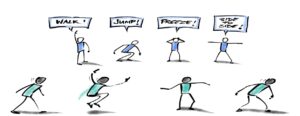
Teaching Points
- Children should perform the actions on the spot.
- Head up to look where you are going.
- Keep varying the way the children move.
- Build up the speed of exercises gradually to increase heart rate.
To make activity harder:
• Introduce more signals – creating your own, or asking the children to think of some movements.
To make activity easier:
• Call out the action, and/or perform the action with the children as well as the visual signal.
Move Your Feet
5 - 10 mins- The aim of this activity is to get the children moving on their feet in different ways.
- Challenge the children to move in the following ways…
- On tiptoes.
- On heels.
- On the balls of feet.
- Taking big steps.
- Taking small steps.
- Moving slowly taking small steps.
- Moving quickly taking small steps.
- Moving slowly taking big steps.
- Moving quickly taking big steps.
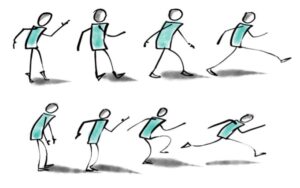
Teaching Points
- Remind pupils to move with their head up and looking where they are going.
- Move carefully around the space avoiding other children.
- Select good examples of movements to demonstrate to the rest of the class.
- Move with control.
To make activity harder:
• Perform the actions quicker. Keep changing the ways the children move.
To make activity easier:
• Allow children more time to explore the different movements.
Knowledge Check
- PROCEDURAL KNOWLEDGE: Ask some children to demonstrate the activity/skill.
- DECLARATIVE KNOWLEDGE: Ask other children to describe what is required to perform the task with success.
How to Stop
5 - 10 mins- The aim of this activity is to teach the children how to stop when running.
- All the children work on their own in a set area.
- Ask the children to jog around the area.
- On the signal “Stop” the children should stop as quickly as possible and freeze.
- Introduce the key teaching points of how to stop to the children gradually:
– Slow the legs down as quickly as possible.
– Take quick, short steps when stopping.
– Very slightly lean back.
- After introducing each of the key points ask the children to have a go at stopping using the new technique and remembering the steps.
- Keep reminding the children of the steps, and calling “stop” for the children to practise.
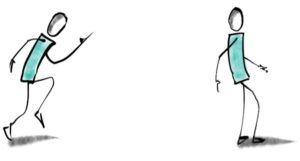
Teaching Points
- Remind children about space, and ensuring they are moving into space and looking where they are going.
- Move carefully around the space avoiding other children.
- Keep emphasising all the points as others are introduced.
- Encourage a good upright posture whilst running.
To make activity harder:
• Give each child a marker spot to place on the ground. Ask each child to run at their marker spot and stop as close to it as they can using the correct technique.
• Ask the children to move quicker before calling stop.
To make activity easier:
• Slow the movement down to a speed walk.
Knowledge Check
- PROCEDURAL KNOWLEDGE: Ask some children to demonstrate the activity/skill.
- DECLARATIVE KNOWLEDGE: Ask other children to describe what is required to perform the task with success.
Listen for the Whistle
5 - 10 mins- Children walk around the area using all the space.
- When they hear the whistle, the children must stop/freeze.
- Keep repeating the activity.
- Ask the children to move in different ways e.g. Jog, skip, jump, hop.
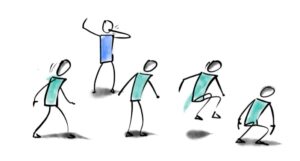
Teaching Points
- Listen out for the whistle and freeze when you hear it.
- Head up and looking forward to see where you are going.
- Move carefully around the space on their own, avoiding other children.
- Vary the way of travelling e.g. hopping, skipping, galloping.
- Move into the free spaces.
Progression: When the whistle is blown more than once, different actions are completed…
- Twice – Touch the floor with both hands, then jump up.
- Three Times – Perform 3 star jumps.
To make activity harder:
- • Choose faster movements.
Knowledge Check
- PROCEDURAL KNOWLEDGE: Ask some children to demonstrate the activity/skill.
- DECLARATIVE KNOWLEDGE: Ask other children to describe what is required to perform the task with success.
Coloured Cone Stopping
3 - 5 mins- In a large area, place lots of different coloured cones out.
- Ask the children to jog around the area moving in and out of the cones without touching them.
- Call out the colour of one of the cones.
- The children should quickly move towards a cone and stop right before it, using the technique practised throughout the lesson.
- The teacher should keep calling out different coloured cones.
- Begin with jogging, but gradually decrease the speed of the movement to a walk.
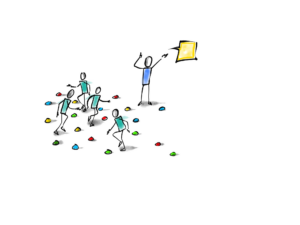
Teaching Points
- Ensure several cones of each colour are placed out to avoid crowding.
- Remind pupils how to stop safely…
– Slow the legs down as quickly as possible.
– Take quick, short steps when stopping.
– Very slightly lean back.
– Gradually slow the activity down.
Knowledge Check
How did you move around during the lesson?
- Encourage the children to think of and describe the different ways they moved during the lesson
How do you stop?
- Encourage the children to think of the key teaching points from the lesson Slow the legs down as quickly as possible; Take quick, short steps when stopping; Very slightly lean back
What did you do well today?
- Encourage the children to think of what they have done well during the lesson
Get lesson 1 of all sports: Sign up for a free pe planning membership